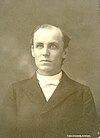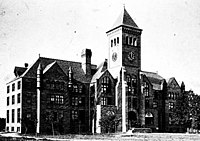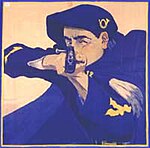History of Duke University
The history of Duke University began when Brown's Schoolhouse, a private subscription school in Randolph County, North Carolina (in the present-day town of Trinity), was founded in 1838.
Finally moving to Durham in 1892, the school grew rapidly, primarily due to the generosity of Washington Duke and Julian S. Carr, powerful and respected Methodists who had grown wealthy through the tobacco industry.
To keep the school operating, the trustees agreed to provide free education for Methodist preachers in return for financial support by the church, and in 1859 the transformation was formalized with a name change to Trinity College and the adoption of the motto "Eruditio et Religio," meaning "Knowledge and Religion."
Committed to the German university model which emphasized research over recitation, Crowell directed a major revision in the curriculum and convinced the trustees to move to a more urban location.
Popular professor John Spencer Bassett published an article in the South Atlantic Quarterly entitled "Stirring Up the Fires of Race Antipathy" in October 1903.
Near the end of the article, he wrote "...Booker T. Washington [is] the greatest man, save General Lee, born in the South in a hundred years..."[4] This led to an outpouring of anger from powerful Democratic party leaders as well as the media and public.
"[4] In 1905, President Theodore Roosevelt commended Trinity and Bassett's courageous stand for academic freedom while speaking to the university.
As World War I ended, the Trinity College Board of Trustees lifted their quarter-century ban of football on campus, leading to an interest in naming the athletic teams.
[5] The team was then known as the Trinity Eleven, the Blue and White, or the Methodists (as opposed to the Baptists of nearby rival Wake Forest University).
None of the nominations proved to be a clear favorite, but the name Blue Devils elicited criticism that could potentially engender opposition on campus.
Editor-in-chief William H. Lander and managing editor Mike Bradshaw began referring to the athletic teams as the Blue Devils.
By 1930, the majority of the Gothic Revival buildings on the campus one mile (1.6 km) west were completed in order to accommodate the Undergraduate Trinity College for men as well as the professional schools.
In athletics, Duke hosted and competed in the only Rose Bowl game ever played outside of California in Wallace Wade Stadium in 1942.
[8] That year, Duke desegregated when five black students, Mary Harris, Gene Kendall, Wilhelmina Reuben-Cooke, Cassandra Smith Rush, and Nathaniel White, enrolled at the university.
[9] Increased activism on campus during the 1960s sparked Martin Luther King Jr. to speak to the university on the civil rights movement's progress on November 14, 1964.
Provoked by the assassination of Martin Luther King Jr., students, faculty, and nonacademic workers participated in The Silent Vigil at Duke University, a peaceful protest that not only demanded collective bargaining rights for the campus' unofficial workers' union, but also advocated against racial discrimination in the local area.
The former governor of North Carolina, Terry Sanford, was elected president in 1969, propelling the Fuqua School of Business's opening.
Later that year, the Terry Sanford Institute of Public Policy relocated to a new building and new dorms opened on East Campus.
In the 2000s (decade), campus growth has shown no signs of slowing down (see Construction projects at Duke University).
[14] The Duke Global Health Research Building, one of four laboratories in the U.S. attempting to "develop new vaccines, drugs, and tests to fight infectious diseases for a Duke-led consortium of universities," broke ground.
Also undergoing construction was the Duke Smart House, a 4,500-square-foot (420 m2) research center in which undergraduates explore resource-efficient design.







